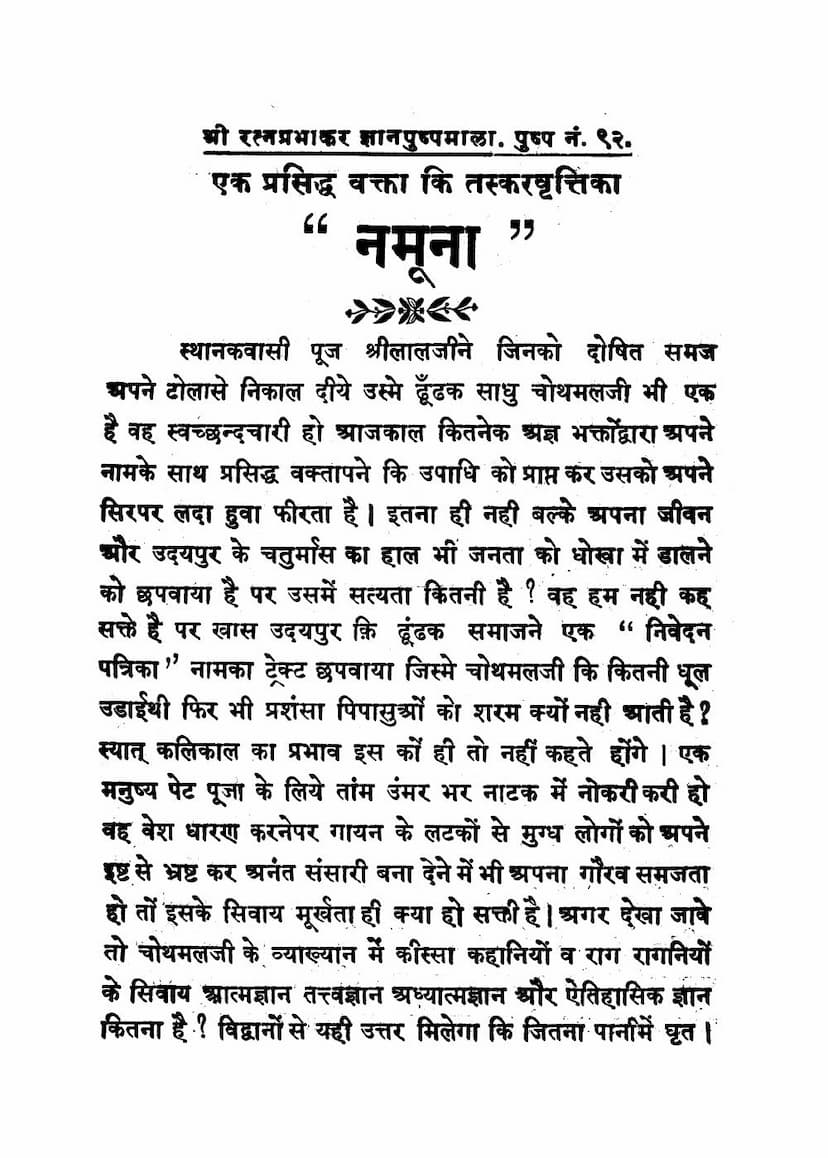Ek Prasiddh Vakta Ki Taskar Vrutti Ka Namuna
Added to library: September 1, 2025

Summary
Here's a comprehensive summary of the Jain text "Ek Prasiddh Vakta Ki Taskar Vrutti Ka Namuna" by Gunsundarsuri, based on the provided pages:
Core Accusation: The text is a strong critique and accusation leveled against a particular "famous orator" named Chotmalji, who is identified as a "Dhundaak Sadhu" (a sect within Jainism often criticized by the author's lineage). The central theme is Chotmalji's alleged "Taskar Vrutti" (thieving or plagiarizing tendency), particularly in his retelling of the Shripal Charitra (life story of King Shripal).
Key Arguments and Criticisms:
- Misleading the Public: Chotmalji is accused of deceiving devotees by presenting himself as a "famous orator" and publishing his account of his life and a Chaturmas (a four-month monastic retreat) in Udaipur, which the author questions the veracity of.
- Lack of True Knowledge: The author contends that Chotmalji's lectures primarily consist of stories and musical renditions, lacking substantive philosophical, spiritual, or historical knowledge. The analogy used is "as much ghee in a paan" (meaning very little or insignificant).
- Intellectual Weakness and Plagiarism:
- Chotmalji is described as "agya-apathit" (ignorant and unlearned).
- The author claims Chotmalji has cobbled together a version of the Shripal Charitra based on works he doesn't acknowledge.
- The most significant accusation is that Chotmalji has plagiarized and manipulated the "Shripal Raas" (a poetic composition on Shripal's life) by the esteemed scholars Upadhyay Vinayvijayji and Yashovijayji Maharaj.
- Distortion of the Shripal Charitra:
- Removal of Temple and Idol Worship: The primary evidence for plagiarism is Chotmalji's alleged removal or alteration of passages in the Shripal Charitra that describe temple worship, idol veneration, and the significance of the Siddha Chakra. This is a core point of contention, as the author's tradition likely supports these practices, while the Dhundaak sect generally opposes them.
- Altering the Narrative: Chotmalji is accused of deliberately omitting entire sections from the original texts (Prakrit, Sanskrit, and the Raas) that describe devotional acts like visiting temples and praying to Jinendra, replacing them with his own versions.
- Substitution of Content: In one instance, Chotmalji is accused of replacing the description of a "Charan Muni" (a sage who travels in the sky) introducing Shripal to the king with Shripal speaking directly to Ren Manjusha, his wife.
- Misrepresenting the Purpose of Religious Acts: The author highlights how Chotmalji selectively uses parts of the original texts, discarding sections related to temple construction and spiritual practices while retaining those about charity and renunciation, thereby distorting the overall message.
- Motivation for Plagiarism: The author suggests Chotmalji's motive is to deceive the Dhundaak community by creating a narrative that aligns with their sect's anti-idol worship stance. He is seen as a "bhava taskar" (a spiritual thief) causing people to fall into further cycles of birth and death.
- Comparison with Previous Dhundaak Opposition: The text points out that even earlier Dhundaak figures who opposed idol worship did not dare to alter the sacred Shripal Charitra. This highlights Chotmalji's transgression as particularly egregious.
- Warning and Call to Action:
- The author urges the Dhundaak community to reject Chotmalji's fabricated Shripal Charitra, drawing a parallel to their rejection of another Dhundaak publication.
- He warns Chotmalji that his "thieving" will not go unnoticed in this age of research and investigation.
- The text concludes with a strong warning to the Dhundaak community, suggesting that if they persist in such practices, the author will unleash further criticisms and counter-arguments, comparing it to providing "medicine" for their "madness."
Overall Tone: The tone is highly critical, accusatory, and polemical. The author uses strong language and rhetorical questions to expose what he perceives as Chotmalji's deceit and intellectual dishonesty. The text serves as a defense of traditional Jain practices, particularly idol worship and temple rituals, against what the author views as the misinterpretations and plagiarisms of the Dhundaak sect.